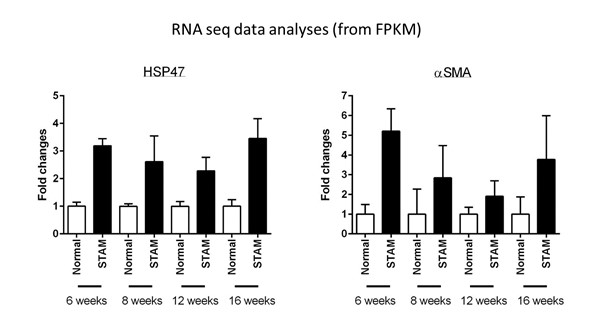Fibrosis-related factors and pathogenesis of STAM mice
Today, we would like to introduce the correlation between our proprietary STAMTM model and fibrosis-related factors such as HSP47.
NASH is a progressive liver disease that differs from simple fatty liver in that it has a risk of developing liver fibrosis and eventually liver cancer.
As the later stages of liver fibrosis, including cirrhosis and hepatocellular carcinoma, are associated with the risk of liver failure and death, improvement of liver fibrosis is an important element of NASH treatment strategy.
Liver fibrosis in NASH
It is known that hepatic stellate cells are transformed into collagen-producing myofibroblast-like cells by cytokines such as TGFβ and MCP-1, that are produced as a result of chronic inflammation.
Collagen is biosynthesized in an immature state in the fibroblast, and then folded and extracellularly produced as mature collagen.
Several molecules are involved in the folding of collagen. Among them, HSP47 has a particularly collagen-specific function.
The expression of HSP47 is upregulated in hepatic fibrosis[1], and HSP47 has been developed as a drug target for the treatment of fibrosis, and recently NASH.
The following data is fibrosis-related factors including HSP47, excerpts from the results of RNA seq performed using the STAMTM model.
The increased expression trend in both genes was confirmed at all ages, suggesting that this model can be used for assessing the efficacy of therapeutic drugs targeting fibrosis-related factors.

[1]: KE Brown et al. Lab Invest. 2005
We have obtained time-course RNA seq data of this model, and are happy to share the behavior of target factors other than the genes analyzed in this study if requested.
In addition to the STAMTM model, we also have diet-induced NASH models, as well as acute liver disease and cirrhosis models.
We also have many models of inflammation and fibrosis in other organs, so please contact us.
